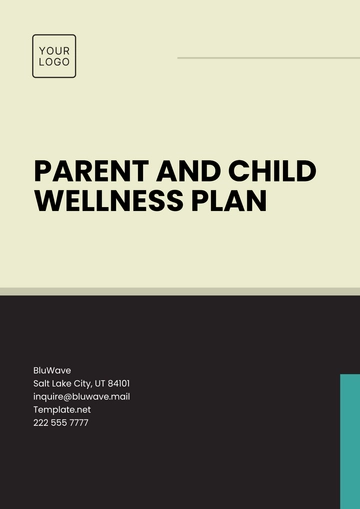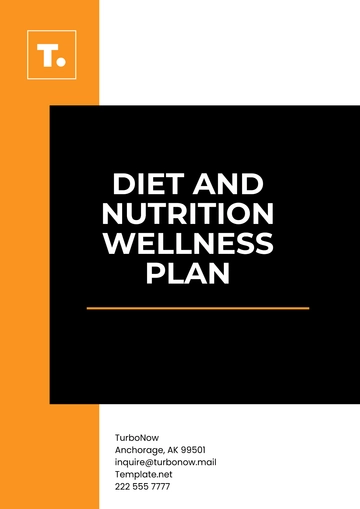Free Women???s Wellness Plan

Prepared by: [Your Name]
Company: [Your Company Name]
Date: [Insert Date]
I. Introduction
Women’s wellness is a comprehensive approach to health that recognizes the unique needs and challenges women face throughout their lives. The Women’s Wellness Plan is designed to empower women to take charge of their physical, mental, and emotional health. This plan promotes awareness, education, and access to resources to ensure holistic well-being. It emphasizes preventive care, regular screenings, healthy lifestyle practices, and support for mental health and reproductive health.
II. Vision and Goals
A. Vision
To create a supportive environment where women thrive in every aspect of their well-being by fostering a culture of health, empowerment, and resilience.
B. Goals
Promote Preventive Health
Encourage regular health checkups, screenings, and vaccinations to detect and prevent illnesses early.Empower Women with Knowledge
Provide educational resources on topics such as reproductive health, nutrition, exercise, mental health, and chronic disease prevention.Support Mental Wellness
Address mental health challenges through counseling, stress management, and resilience training.Enhance Physical Wellness
Promote fitness programs, nutritional counseling, and weight management to encourage a healthy lifestyle.Address Reproductive Health Needs
Provide education and services related to menstrual health, pregnancy, family planning, and menopause.Focus on Women-Specific Conditions
Increase awareness and preventive measures for conditions such as breast cancer, ovarian cancer, osteoporosis, and autoimmune diseases.Foster Community Support
Build a network of support groups and mentorship opportunities to enhance social well-being.
III. Key Areas of Focus and Strategies
A. Health Education and Awareness
Strategies:
Educational Campaigns: Create campaigns to raise awareness about women’s health issues such as breast cancer, cervical cancer, and menopause.
Workshops and Seminars: Host sessions on topics like reproductive health, nutrition, exercise, and stress management.
Resource Distribution: Share brochures, online guides, and videos that provide actionable steps for achieving better health.
Social Media Outreach: Use digital platforms to promote health tips, wellness challenges, and success stories.
B. Physical Health and Nutrition
Strategies:
Fitness Classes: Offer yoga, Pilates, and cardio sessions designed for women of all ages and fitness levels.
Healthy Eating Initiatives: Conduct cooking classes, meal-planning workshops, and nutritional counseling sessions.
Weight Management Programs: Provide support groups and coaching for sustainable weight management.
Chronic Disease Prevention: Develop targeted programs for diabetes, hypertension, and osteoporosis prevention.
C. Mental Health and Emotional Well-being
Strategies:
Stress Management Programs: Teach mindfulness, meditation, and other stress-reduction techniques.
Counseling Services: Provide access to professional counselors and therapists for mental health challenges.
Support Groups: Create spaces for women to share experiences and offer mutual support.
Resilience Building: Host workshops on coping mechanisms and fostering a positive outlook.
D. Reproductive Health and Wellness
Strategies:
Access to Services: Ensure availability of gynecological exams, family planning services, and prenatal care.
Educational Resources: Offer classes on menstrual health, pregnancy, childbirth, and menopause.
Fertility Support: Provide information on fertility preservation, treatments, and emotional support for infertility challenges.
Postpartum Care: Offer resources and counseling for new mothers to support physical and emotional recovery.
E. Prevention and Screenings
Strategies:
Regular Screenings: Promote mammograms, pap smears, bone density tests, and cardiovascular health assessments.
Vaccination Clinics: Provide HPV, flu, and other recommended vaccines for women.
Skin and Breast Health: Teach self-examination techniques for early detection of skin and breast abnormalities.
Annual Wellness Checks: Encourage comprehensive check-ups to monitor overall health.
F. Social and Community Support
Strategies:
Mentorship Programs: Connect women with mentors for guidance in career, health, and personal development.
Community Events: Host wellness fairs, charity walks, and women-focused networking events.
Accessible Resources: Partner with local organizations to provide free or low-cost health and wellness services.
Outreach to Vulnerable Groups: Target underserved communities with tailored health programs and resources.
IV. Implementation Plan
A. Roles and Responsibilities
Healthcare Providers: Conduct screenings, offer counseling, and provide necessary medical care.
Wellness Coaches: Guide women in creating personalized health and fitness plans.
Community Leaders: Advocate for women’s wellness initiatives and organize local events.
Nonprofit Organizations: Support underserved women through funding, programs, and volunteer efforts.
B. Timeline
Phase 1 (Months 1-3): Launch awareness campaigns and begin educational workshops.
Phase 2 (Months 4-6): Introduce physical and mental health programs, including fitness and counseling services.
Phase 3 (Months 7-12): Expand reproductive health services, enhance outreach, and evaluate program effectiveness.
Ongoing: Maintain regular screenings, workshops, and wellness initiatives.
V. Evaluation and Assessment
A. Key Performance Indicators (KPIs)
Increased participation in screenings and fitness programs.
Higher vaccination rates among women.
Improved mental health outcomes reported by participants.
Greater awareness of reproductive health options and services.
Adoption of healthier lifestyle behaviors, including diet and exercise.
B. Methods of Evaluation
Collect participant feedback through surveys and focus groups.
Monitor attendance at events and workshops.
Track health improvements through screening data and follow-ups.
Analyze program reach and impact within the community.
VI. Sustainability Plan
Strategies:
Partnership Development: Collaborate with healthcare providers, businesses, and nonprofits to sustain programs.
Grant Applications: Secure funding from government and private entities for long-term support.
Volunteer Engagement: Encourage community involvement to expand the program’s reach.
Ongoing Education: Maintain a continuous flow of health information through newsletters, webinars, and social media.
VII. Conclusion
The Women’s Wellness Plan is a comprehensive initiative to promote holistic health among women of all ages. By focusing on preventive care, education, and access to resources, the plan aims to empower women to lead healthier, happier lives. Through collaboration, community involvement, and sustained efforts, this plan will create a supportive environment where women can thrive physically, mentally, and emotionally.
- 100% Customizable, free editor
- Access 1 Million+ Templates, photo’s & graphics
- Download or share as a template
- Click and replace photos, graphics, text, backgrounds
- Resize, crop, AI write & more
- Access advanced editor
You may also like
- Finance Plan
- Construction Plan
- Sales Plan
- Development Plan
- Career Plan
- Budget Plan
- HR Plan
- Education Plan
- Transition Plan
- Work Plan
- Training Plan
- Communication Plan
- Operation Plan
- Health And Safety Plan
- Strategy Plan
- Professional Development Plan
- Advertising Plan
- Risk Management Plan
- Restaurant Plan
- School Plan
- Nursing Home Patient Care Plan
- Nursing Care Plan
- Plan Event
- Startup Plan
- Social Media Plan
- Staffing Plan
- Annual Plan
- Content Plan
- Payment Plan
- Implementation Plan
- Hotel Plan
- Workout Plan
- Accounting Plan
- Campaign Plan
- Essay Plan
- 30 60 90 Day Plan
- Research Plan
- Recruitment Plan
- 90 Day Plan
- Quarterly Plan
- Emergency Plan
- 5 Year Plan
- Gym Plan
- Personal Plan
- IT and Software Plan
- Treatment Plan
- Real Estate Plan
- Law Firm Plan
- Healthcare Plan
- Improvement Plan
- Media Plan
- 5 Year Business Plan
- Learning Plan
- Marketing Campaign Plan
- Travel Agency Plan
- Cleaning Services Plan
- Interior Design Plan
- Performance Plan
- PR Plan
- Birth Plan
- Life Plan
- SEO Plan
- Disaster Recovery Plan
- Continuity Plan
- Launch Plan
- Legal Plan
- Behavior Plan
- Performance Improvement Plan
- Salon Plan
- Security Plan
- Security Management Plan
- Employee Development Plan
- Quality Plan
- Service Improvement Plan
- Growth Plan
- Incident Response Plan
- Basketball Plan
- Emergency Action Plan
- Product Launch Plan
- Spa Plan
- Employee Training Plan
- Data Analysis Plan
- Employee Action Plan
- Territory Plan
- Audit Plan
- Classroom Plan
- Activity Plan
- Parenting Plan
- Care Plan
- Project Execution Plan
- Exercise Plan
- Internship Plan
- Software Development Plan
- Continuous Improvement Plan
- Leave Plan
- 90 Day Sales Plan
- Advertising Agency Plan
- Employee Transition Plan
- Smart Action Plan
- Workplace Safety Plan
- Behavior Change Plan
- Contingency Plan
- Continuity of Operations Plan
- Health Plan
- Quality Control Plan
- Self Plan
- Sports Development Plan
- Change Management Plan
- Ecommerce Plan
- Personal Financial Plan
- Process Improvement Plan
- 30-60-90 Day Sales Plan
- Crisis Management Plan
- Engagement Plan
- Execution Plan
- Pandemic Plan
- Quality Assurance Plan
- Service Continuity Plan
- Agile Project Plan
- Fundraising Plan
- Job Transition Plan
- Asset Maintenance Plan
- Maintenance Plan
- Software Test Plan
- Staff Training and Development Plan
- 3 Year Plan
- Brand Activation Plan
- Release Plan
- Resource Plan
- Risk Mitigation Plan
- Teacher Plan
- 30 60 90 Day Plan for New Manager
- Food Safety Plan
- Food Truck Plan
- Hiring Plan
- Quality Management Plan
- Wellness Plan
- Behavior Intervention Plan
- Bonus Plan
- Investment Plan
- Maternity Leave Plan
- Pandemic Response Plan
- Succession Planning
- Coaching Plan
- Configuration Management Plan
- Remote Work Plan
- Self Care Plan
- Teaching Plan
- 100-Day Plan
- HACCP Plan
- Student Plan
- Sustainability Plan
- 30 60 90 Day Plan for Interview
- Access Plan
- Site Specific Safety Plan





























